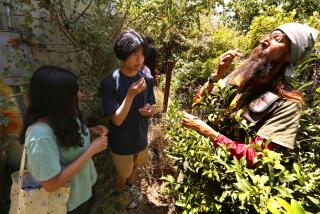One city, two schools -- infinite dreams
This is the tale of two city schools, one celebrating its centenary, the other still a gleam in its would-be founderâs eye; one a tangible testament to much that has happened to this city, the other a blueprint for what could happen next.
The shadows of phone and power lines crisscross the sidewalk in front of St. Michaelâs Elementary School like lash marks; they are the only thing on the corner of 87th Street and Vermont Avenue that could be considered shade. Although there are houses on 87th, Vermont and nearby Manchester Avenue are sun-bleached corridors of traffic, billboards and strip malls anchored by liquor stores and check cashing establishments. The red-brick charm of St. Michaelâs makes almost no sense here.
Inside, Sister Mary Catherine Antczak explains it all. She is the principal of St. Michaelâs, and on her desk is the photographic history of the school, and in a way, of Los Angeles itself.
In 1903, John Wagner, a German farmer living in the rural community known as Manchester Heights, decided that his children and the children of his neighbors and kin would benefit mightily from a Catholic education. So he built a two-room wooden schoolhouse at what would become the corner of Manchester and Vermont avenues and asked the Dominican Sisters of Mission San Jose if they couldnât spare a few teachers. He named the school St. Michaelâs because his fatherâs name was Michael; five years later, St. Michaelâs the church followed.
The first yearâs enrollment was 43, a dozen or so of them Wagners. A photo from the first day of school shows a porch full of solemn, round-faced farmerâs children in dark dresses and knee-pants. Most of the faces are white, many of German or Irish descent.
Flipping through decades class pictures, one can see how the school grew and the hairstyles changed. More kids could afford glasses, but the faces remained remarkably the same -- working- and middle-class white. Then in early â60s, the mix begins to change; in 1965, there are black faces among the white. By 1972, most of the faces are black, with a few Latinos mixed in.
This year the school has 240 students; about half of them are African American, half are Latino. They move through the hallways in semi-straight lines trying not to push, trying not to karate chop. The girlsâ hair is mostly long and dark, the boysâ barely there. Though they do their level best to maintain silence, you can hear a class coming from yards away -- the choked-back sound of closed-mouth laughter and quick whispers runs ahead of them like creek water after rain.
The wooden schoolhouse is gone; the red brick building was built in 1926 and an annex was added in 1955. A few months ago, the school was falling apart -- the boiler had burst, there was no heat, the windows were too old to close or open properly, ceilings were coming down and many of the walls ran with water, even when it wasnât raining. But there was nothing to be done because there simply wasnât any money. Or as Antczak puts it: âGiven the reality of who we serve, the operating budget has been starved regarding maintenance and capitol improvement.â
Then Catholic philanthropists John and Dorothy Shea stepped in with a complete renovation -- new roof, new windows, new floors, new paint, new heat. At 100 years old, the school looks, and smells, like a million bucks.
âMany people arenât accustomed to places like this,â Antczak says, referring to the neighborhood where there are bars on most windows. âBut when they come here, and then they see. They see how important schools like this, communities like this, are.â
St. Michaelâs is a living refutation of the myth of transient Los Angeles. Some of the teachers have been here for 15, 20, 30 years. Many of the students are second- and third-generation St. Michaelâs. Antczak, who is white, was born not far from here, at 57th and Vermont. She worked here as teacher and then principal from 1975 to 1986 and taught the parents of some of her current students.
She believes, as many educators believe, that the best, truest hope for improving any situation, including a neighborhood staggering under 40 years of economic blight, is the children. âItâs a privilege to be able to minister in a community that has familial roots,â Antczak says. âThe names of the streets here are part of my familyâs history too.â
Studying downtown L.A.
Some 20 miles away, Jacki Breger shares the sisterâs attachment to the streets of Los Angeles. If she has her way, she will create an entire curriculum devoted to exploring the history and significance of their names as part of the first charter school to revolve around the study of downtown Los Angeles.
Nine years ago, Breger, a folk singer and music educator, was asked to help out with CityLife, a summer program that allows poor and at-risk youths to explore downtown Los Angeles in all its grit and grandeur. The camp was run out of California Plaza and there was little money for field trips. So the kids visited the Museum of Contemporary Art and the Broadway theaters and City Hall, got as far west as the Los Angeles County Museum of Art, as far south as Watts. Walking the streets of downtown, Breger had an epiphany similar to the one Antczak describes.
âI had a bad impression of downtown,â says Breger, who lived in Santa Monica when she began working with CityLife. âBut after spending a lot of time here, I realized how rich it was, how important.â
Breger, who ran various local summer camps for many years, believes kids have to do to learn and so one summer she had her students -- typically 15 to 25 middle-school kids -- come up with arguments for and against the demolition of St. Vibianaâs cathedral. Other years, they worked with developer Tom Gilmore to figure out what makes a city block worthy of market-rate housing and designed a community garden for Bunker Hill. This model of student as urban anthropologist is the keystone of CityLife Downtown Charter School, which Breger hopes will open next fall.
âI saw how doing this kind of thing for five weeks changed the kids,â she says. âImagine what it would be like if we had them for seven years.â
Breger plans to open the school with 120 pupils in grades six and seven. So far, she has a $400,000 implementation grant from the California Department of Education, a $150,000 grant from National Council of La Raza, a principal and a lot of support. She doesnât yet have the $300,000 she figures sheâll need for start-up expenses or a school site, though she has several possibilities, all in downtown.
Although the school is open to all Californians, the point is to serve the families living in Boyle Heights, Little Tokyo, Chinatown, Pico-Union and South Park. To educate them, yes, but also to show them, and the rest of the world, the real value of where they live. Roots, the things that hold us steady, can grow any time; 100 years from now whoâs to say which school will be the truest mirror of change?
This is the tale of two city schools, one that has struggled as the city has struggled, the other that may be part of the much anticipated renaissance of downtown Los Angeles. There is a lot of fancy talk these days about the Grand Avenue corridor, about the cafes and cultural edifices that the city has erected in the last 10 years. But a city does not live on bruschetta and architecture alone -- a vital city must have people living in it. People who need places to eat that are neither Pinot nor Popeyeâs, people who need trees and shade as much as those who live in the suburbs, people who have children who should be able to go to school near their homes.
St. Michaelâs is a traditional Catholic school, but somehow watching the girls little and big smile every time they walk into the pretty pink wonder of their new bathroom makes Jacki Bregerâs dream school seem quite possible.
And more than that. It makes it easier for even the most cynical among us to believe that Los Angeles the city may really, truly, finally be turning around.
More to Read
Sign up for Essential California
The most important California stories and recommendations in your inbox every morning.
You may occasionally receive promotional content from the Los Angeles Times.











